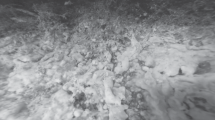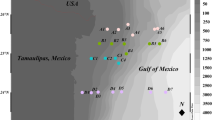Abstract
The spatio-temporal distribution of sulfate-reducing bacteria (SRB) in the microbial mat of Camargue (Salins-de-Giraud, France) was investigated by molecular approaches at both microscale spatial resolution and different taxonomic organization levels. The vertical distribution of the SRB populations was correlated with oxygen and sulfide microgradient fluctuations. Comparisons of Terminal restriction fragment length polymorphism (T-RFLP) fingerprints showed distinct locations of some operational taxonomic units at daytime and at night (4:00 or 15:00 hours) revealing important differences on the structures of the bacterial communities. When oxygen penetrates the mat, SRB migration was observed either downward to reach deeper anoxic zones to escape oxygen or upward to reach oxic surface zones. When no migration was observed, both metabolism switches and aggregate formations were suspected. These behaviors allowed the aerotolerant SRB to deal with oxygen. The analysis of the Desulfococcus–Desulfonema–Desulfosarcina T-RFLP profiles revealed up-migrating populations related to both Desulfonema sp. and Desulfosarcina variabilis. T-RFLP profiles combined with 16S ribosomal ribonucleic acid gene library analysis of the Desulfobacter group revealed two distinct populations: a population related to the recently described Desulfotignum genus migrating upward during the night and a population of a new species of the Desulfobacter uniformly located throughout the mat independent of the period. Thus, the identification of the new oxygen-tolerant SRB will provide the basis for understanding the physiological adaptations to oxygen.





Similar content being viewed by others
References
Baumgartner LK, Reid RP, Dupraz C, Decho AW, Buckley DH, Spear JR, Przekop KM, Visscher, PT (2006) Sulfate reducing bacteria in microbial mats: changing paradigms, new discoveries. Sediment Geol 185:131–145
Canfield DE, Des Marais DJ (1991) Aerobic sulfate reduction in microbial mats. Science 251:1471–1473
Caumette P, Matheron R, Raymond N, Relexans JC (1994) Microbial mats in the hypersaline ponds of Mediterranean salterns (Salins-de-Giraud, France). FEMS Microbiol Ecol 13:273–286
Cohen Y (1984) Oxygenic photosynthesis, anoxygenic photosynthesis, and sulfate reduction in cyanobacterial mats. In: Klug MJ, Ready CA (eds) Current perspectives in microbial ecology. American Society for Microbiology, Washington, DC, pp 435–441
Cypionka H, Widdel F, Pfennig N (1985) Survival of sulfate-reducing bacteria after oxygen stress, and growth in sulfate-free oxygen-sulfide gradients. FEMS Microbiol Lett 31:39–45
Daly K, Sharp RJ, McCarthy AJ (2000) Development of oligonucleotide probes and PCR primers for detecting phylogenetic subgroups of sulfate-reducing bacteria. Microbiology 146:1693–1705
Dannenberg S, Kroder M, Dilling W, Cypionka H (1992) Oxidation of H2, organic compounds and inorganic sulfur compounds coupled to reduction of O2 or nitrate by sulfate reducing-bacteria. Arch Microbiol 158:93–99
Dilling W, Cypionka H (1990) Aerobic respiration in sulfate-reducing bacteria. FEMS Microbiol Lett 71:123–128
Dolla A, Fournier M, Dermoun Z (2006) Oxygen defense in sulfate-reducing bacteria. J Biotechnol 126:87–100
Dolla A, Fu R, Brumlik MJ, Voordouw G (1992) Nucleotide sequence of dcrA, a Desulfovibrio vulgaris Hildenborough chemoreceptor gene and its expression in Escherichia coli. J Bacteriol 174:1726–1733
Eschemann A, Kühl M, Cypionka H (1999) Aerotaxis in Desulfovibrio. Environ Microbiol 1:489–494
Ferris MJ, Ward DM (1997) Seasonal distributions of dominant 16S rRNA-defined populations in a hot spring microbial mat examined by denaturing gradient gel electrophoresis. Appl Environ Microbiol 63:1375–1381
Foti M, Sorokin DY, Lomans B, Mussman M, Zacharova EE, Pimenov NV, Kuenen JG, Muyzer G (2007) Diversity, activity, and abundance of sulfate-reducing bacteria in saline and hypersaline soda lakes. Appl Environ Microbiol 73:2093–2100
Fourçans A, García de Oteyza T, Wieland A, Solé A, Diestra E, van Bleijswijk J, Grimalt JO, Kühl M, Esteve I, Muyzer G, Caumette P, Duran R (2004) Characterization of functional bacterial groups in a hypersaline microbial mat community (Salins-de-Giraud, Camargue, France). FEMS Microbiol Ecol 51:55–70
Fourçans A, Solé A, Diestra E, Ranchou-Peyruse A, Esteve I, Caumette P, Duran R (2006) Vertical migration of phototrophic bacterial populations in a hypersaline microbial mat from Salins-de-Giraud (Camargue, France). FEMS Microbiol Ecol 57:367–377
Fournier M, Zhang Y, Wildschut JD, Dolla A, Voordouw JK, Schriemer DC, Voordouw G (2003) Function of oxygen resistance proteins in the anaerobic, sulfate-reducing bacterium Desulfovibrio vulgaris Hildenborough. J Bacteriol 185:71–79
Fründ C, Cohen Y (1992) Diurnal cycles of sulfate reduction under oxic conditions in cyanobacterial mats. Appl Environ Microbiol 58:70–77
Fukui M, Teske A, Aßmus B, Muyzer G, Widdel F (1999) Physiology, phylogenetic relationships, and ecology of filamentous sulfate-reducing bacteria (genus Desulfonema). Arch Microbiol 172:193–203
Giani D, Seeler J, Giani L, Krumbein WE (1989) Microbial mats and physicochemistry in a saltern in the Bretagne (France) and in a laboratory scale saltern model. FEMS Microbiol Ecol 62:151–162
Jonkers HM, Koh IO, Behrend P, Muyzer G, de Beer D (2005) Aerobic organic carbon mineralization by sulfate-reducing bacteria in the oxygen-saturated photic zone of a hypersaline microbial mat. Microb Ecol 49:291–300
Jørgensen BB (1994) Sulfate reduction and thiosulfate transformations in a cyanobacterial mat during a diel oxygen cycle. FEMS Microbiol Ecol 13:303–312
Kovach WL (1999) MVSP - a Multivariate Statistical Package for Windows. ver. 3.1. ed. Kovack Computing Services, Wales, UK
Krekeler D, Sigalevich P, Teske A, Cohen Y, Cypionka H (1997) A sulfate-reducing bacterium from the oxic layer of a microbial mat from Solar Lake (Sinai), Desulfovibrio oxyclinae sp. nov. Arch Microbiol 167:369–375
Krekeler D, Teske A, Cypionka H (1998) Strategies of sulfate-reducing bacteria to escape oxygen stress in a cyanobacterial mat. FEMS Microbiol Ecol 25:89–96
Kuever J, Konneke M, Galushko A, Drzyzga O (2001) Reclassification of Desulfobacterium phenolicum as Desulfobacula phenolica comb. nov. and description of strain SaxT as Desulfotignum balticum gen. nov., sp. nov. Int J Syst Evol Microbiol 51:171–177
Kumar S, Tamura K, Jakobsen IB, Nei M (2001) MEGA2: molecular evolutionary genetics analysis software. Bioinformatics 17:1244–1245
Lane DJ (1991) 16S/23S rRNA sequencing. In: Stachenbradt E, Goodfellow M (eds) Nucleic acid techniques in bacterial systematics. Wiley, New York, pp 115–175
Liu WT, Marsh TL, Cheng H, Forney LJ (1997) Characterization of microbial diversity by determining terminal restriction fragment length polymorphisms of genes encoding 16S rRNA. Appl Environ Microbiol 63:4516–4522
Maidak BL, Cole JR, Lilburn TG, Parker CT Jr., Saxman PR, Farris RJ, Garrity GM, Olsen GJ, Schmidt TM, Tiedje JM (2001) The RDP-II (Ribosomal Database Project). Nucl Acids Res 29:173–174
Marschall C, Frenzel C, Cypionka H (1993) Influence of oxygen on sulphate reduction and growth of sulphate-reducing bacteria. Arch Microbiol 159:168–173
Minz D, Fishbain S, Green SJ, Muyzer G, Cohen Y, Rittmann BE, Stahl DA (1999) Unexpected population distribution in a microbial mat community: sulfate-reducing bacteria localized to the highly oxic chemocline in contrast to a eukaryotic preference for anoxia. Appl Environ Microbiol 65:4659–4665
Minz D, Flax JL, Green SJ, Muyzer G, Cohen Y, Wagner M, Rittmann BE, Stahl DA (1999) Diversity of sulfate-reducing bacteria in oxic and anoxic regions of a microbial mat characterized by comparative analysis of dissimilatory sulfite reductase genes. Appl Environ Microbiol 65:4666–4671
Mouné S, Caumette P, Matheron R, Willison JC (2003) Molecular sequence analysis of prokaryotic diversity in the anoxic sediments underlying cyanobacterial mats of two hypersaline ponds in Mediterranean salterns. FEMS Microbiol Ecol 44:117–130
Namsaraev ZB, Gorlenko VM, Namsaraev BB, Buriukhaev SP, Iurkov VV (2003) The structure and biogeochemical activity of the phototrophic communities from the Bol’sherechenskii alkaline hot spring. Mikrobiologiia 72:228–238
Ramsing NB, Ferris MJ, Ward DM (2000) Highly ordered vertical structure of Synechococcus populations within the one-millimeter-thick photic zone of a hot spring cyanobacterial mat. Appl Environ Microbiol 66:1038–1049
Ramsing NB, Kühl M, Jørgensen BB (1993) Distribution of sulfate-reducing bacteria, O2, and H2S in photosynthetic biofilms determined by oligonucleotide probes and microelectrodes. Appl Environ Microbiol 59:3840–3849
Revsbech NP, Jorgensen BB, Blackburn TH, Cohen Y (1983) Microelectrode studies of the photosynthesis and O2, H2S and pH profiles of a microbial mat. Limnol Oceanogr 28:1062–1074
Risatti JB, Capman WC, Stahl DA (1994) Community structure of a microbial mat: the phylogenetic dimension. Proc Natl Acad Sci USA 91:10173–10177
Ruff-Roberts AL, Kuenen JG, Ward DM (1994) Distribution of cultivated and uncultivated cyanobacteria and Chloroflexus-like bacteria in hot spring microbial mats. Appl Environ Microbiol 60:697–704
Saitou N, Nei M (1987) The Neighbor-joining Method: a new method for reconstructing phylogenetic trees. Mol Biol Evol 4:406–425
Sass AM, Eschemann A, Kühl M, Tharb R, Sass H, Cypionka H (2002) Growth and chemosensory behavior of sulfate-reducing bacteria in oxygen–sulfide gradients. FEMS Microbiol Ecol 40:47–54
Schink B, Thiemann V, Laue H, Friedrich MW (2002) Desulfotignum phosphitoxidans sp. nov., a new marine sulfate reducer that oxidizes phosphite to phosphate. Arch Microbiol 177:381–391
Sigalevich P, Meshorer E, Helman Y, Cohen Y (2000) Transition from anaerobic to aerobic growth conditions for the sulfate- reducing bacterium Desulfovibrio oxyclinae results in flocculation. Appl Environ Microbiol 66:5005–5012
Sorokin DI, Turova TP, Kuznetsov BB, Briantseva IA, Gorlenko VM (2000) Roseinatronobacter thiooxidans gen. nov., sp. nov., a new alkaliphilic aerobic bacteriochlorophyll-alpha-containing bacteria from a soda lake. Mikrobiologiia 69:89–97
Teske A, Ramsing NB, Habicht K, Fukui M, Kuver J, Jørgensen BB, Cohen Y (1998) Sulfate-reducing bacteria and their activities in cyanobacterial mats of solar lake (Sinai, Egypt). Appl Environ Microbiol 64:2943–2951
Thompson J, Gibson T, Plewniak F, Jeanmougin F, Higgins D (1997) The CLUSTAL_X windows interface: flexible strategies for multiple sequence alignment aided by quality analysis tools. Nucl Acids Res 25:4876–4882
Weisburg, WG, Barns SM, Pelletier DA, Lane DJ (1991) 16S ribosomal DNA amplification for phylogenetic study. J Bacteriol 173:697–703
Whale GF, Walsby AE (1984) Motility of the cyanobacterium Microcoleus chthonoplastes in mud. Phycol J 19:117–123
Wieland A, Kuhl M (2006) Regulation of photosynthesis and oxygen consumption in a hypersaline cyanobacterial mat (Camargue, France) by irradiance, temperature and salinity. FEMS Microbiol Ecol 55:195–210
Wieland A, Kuhl M, McGowan L, Fourçans A, Duran R, Caumette P, Garcia De Oteyza T, Grimalt JO, Solé A, Diestra E, Esteve I, Herbert RA (2003) Microbial mats on the Orkney islands revisited: microenvironment and microbial community composition. Microb Ecol 46:371–390
Wieland A, Zopfi J, Benthien M, Kühl M (2005) Biogeochemistry of an iron-rich hypersaline microbial mat (Camargue, France). Microb Ecol 49:34–49
Wieringa EB, Overmann J, Cypionka H (2000) Detection of abundant sulphate-reducing bacteria in marine oxic sediment layers by a combined cultivation and molecular approach. Environ Microbiol 2:417–427
Acknowledgments
We acknowledge the financial support provided by the EC (MATBIOPOL project, grant EVK3-CT-1999-00010) and by the “Conseil Régional d’Aquitaine.” The authors are grateful to the Company of Salins-du-midi at Salins-de-Giraud for facilitating access to the salterns, sampling, and field experiments. AF is partly supported by a doctoral grant from the general council of Atlantic Pyrenees. Dr. Remignon (ENSAT, Toulouse, France) is gratefully thanked for the technical support. Thanks also to anonymous reviewers for their helpful comments and suggestions. The authors are especially indebted to Prof. Jim Spain and C. Mroz for careful reading of the English and for helpful comments on the paper.
Author information
Authors and Affiliations
Corresponding author
Rights and permissions
About this article
Cite this article
Fourçans, A., Ranchou-Peyruse, A., Caumette, P. et al. Molecular Analysis of the Spatio-temporal Distribution of Sulfate-reducing Bacteria (SRB) in Camargue (France) Hypersaline Microbial Mat. Microb Ecol 56, 90–100 (2008). https://doi.org/10.1007/s00248-007-9327-x
Received:
Revised:
Accepted:
Published:
Issue Date:
DOI: https://doi.org/10.1007/s00248-007-9327-x




